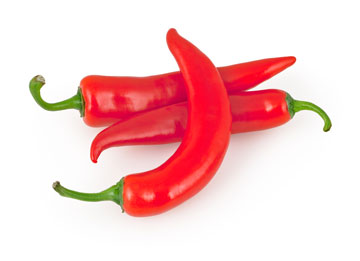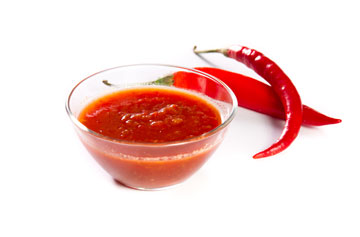
Holiday Hot Sauce

Push past gift cards this holiday season. Consider a spicy hot sauce for someone on your shopping list..
Hot sauce is typically canned using boiling water or the steam canning method. Boiling water or steam canned products must have a high acid content to prevent bacterial growth. For this reason, hot sauce procedures need to be followed closely. Maintain the indicated proportions of hot peppers, onions and garlic, tomatoes, and vinegar. The measurements ensure the product has a pH at or below 4.6, allowing it to be processed at lower temperatures than pressure canning.
When preparing hot sauce, be cautious of capsaicin present in hot peppers. Capsaicin is an active component produced by peppers to ward off animals who would eat them in the wild. It will cause stinging and burning if it touches eyes or other sensitive membranes in humans. Wear plastic or rubber gloves and do not touch your face while handling or cutting hot peppers. If you do not wear gloves, wash hands thoroughly with soap and water before touching your face or eyes.
You can mediate the spiciness of the hot sauce be selecting different pepper varieties. For a mild heat try ancho, banana, or long wax. For a medium heat try pepperoncini. For a hot flavor try a cayenne, habanero, jalapeño, serrano, Tabasco, or Thai. For a very hot flavor try a Scotch bonnet.
Hot peppers are a good source of vitamin C and vitamin A. When preparing any home preservation item as a gift, remember to list ingredients, processing date, and storage/ handling instructions on the label.
Source: Ainsele C., Andress E. (2005, December). Holiday Gifts for The Home Food Preserver. National Center for Home Food Preservation. https://nchfp.uga.edu/tips/winter/hfp_gifts.html. (No longer available online.)
Source: Purdue Extension. (2020). Food link: Hot Pepper. Purdue University https://extension.purdue.edu/foodlink/food.php?food=hot%20pepper.
Source: Ingham, B. (2017, October). Safe Preserving: Using a Steam Canner. University of Wisconsin Extension. https://fyi.extension.wisc.edu/safefood/2017/10/24/safe-preserving-using-a-steam-canner/?ss_redir=1.
Cayenne Pepper Sauce

Ingredients:
- 3 pounds hot peppers (for example, Anaheim, Hungarian, Jalapeños)
- 1/3 cup minced garlic
- 4 cups sliced onion (about 2 medium)
- 1/3 cup stemmed, chopped cilantro
- 3 cans (28 ounces each) diced tomatoes
- 3 cups cider vinegar (5%)
- 2½ cups water
Ingredients:
- Wash, trim and slice peppers and onions into rings, using a mandolin slicer or a food processor. In a 10-quart stockpot, mix together all ingredients. Bring to a boil and boil 1 hour. Reduce heat slightly and simmer 1 additional hour. Turn heat off, and cool mixture slightly.
- Puree vegetables in a blender about 2 minutes per blender batch. Return pureed mixture to stockpot and bring carefully just to a boil. Turn off heat.
- Fill hot sauce into hot, clean pint jars, leaving ½-inch headspace. Process in a boiling water canner for 10 minutes below 1,000 feet of elevation, 15 mininutes for elevations of 1,001–6,000 feet.
This is a very hot sauce. Some suggested uses include:
- adding a small amount to a soup to give it a “spicy-hot” bite.
- stirring a small amount into vegetable dishes to give them an extra “zing.”
- pepping up your cheese dip with a small amount to make it a “hot” item.
- adding some to that pot of chili you’re cooking up – make it fiery!
Source: Andress, E. (2003. September). Cayenne Pepper Sauce. National Center for Home Food Preservation. https://nchfp.uga.edu/how/can_03/cayenne_peppersauce.html.
Do I Really Need to Check My Dial-Gauge Pressure Canner?

Throughout the year, many local university extension offices are busy with requests from home canners asking about the process for testing their dial gauge pressure canner. Sometimes it’s those who’ve canned for years and know they should have the dial gauge tested annually; other times, it’s people who just found out they should have their dial gauge tested.
Most of the gauges tested run high, meaning when the master calibrated gauge reads 11 PSI (or pounds per square inch), the client’s gauge reads 12 or 13 PSI. Using this example, when that dial gauge is used at home at 11 PSI, the canner is processing at 9 or 10 PSI. This means those canned foods are under-processed, which can lead to spoilage, as well as the risk of Clostridium botulinum bacteria not being destroyed and producing the toxin that can cause the disease botulism.
So yes, definitely have your dial-gauge canner tested once per year! Many university extension centers offer this as a service free or for a nominal fee. Check with your local extension office to see if they or a nearby county offer dial gauge canner testing. Keep in mind that the current testing units can only test the following brands : Presto, National, Magic Seal and Made of Honor.
Visit the USDA’s Digital Exhibit on Canning to see how preserving and canning have changed through history, including a display on the “Evolution of Canning Equipment.”